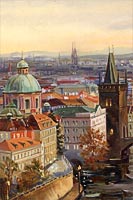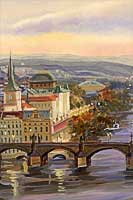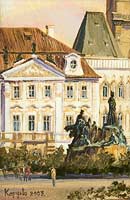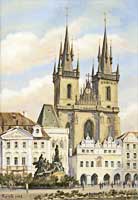MINIATURE is a miniature portrait painting, usually executed in gouache or watercolor.
Portrait miniatures began to flourish in 16th-century Europe and the art was practiced during the 17th and 18th centuries. It was especially valuable in introducing people to each other over distances; a nobleman proposing the marriage of his daughter might send a courier with her portrait to visit potential suitors. Soldiers and sailors might carry miniatures of their loved ones while travelling, or a wife might keep one of her husband while he was away.
The first miniaturists used watercolor to paint on stretched vellum, but in the 18th century, miniatures were also painted on ivory and enamel. As small in size as 40 mm ? 30 mm (1? in ? 1? in), portrait miniatures were often used as personal mementos or as jewelry or snuff box covers.
In the second half of the 19th century, the development of daguerreotypes and photographs contributed to the decline in popularity of the miniatures.
OIL PAINTING Traditional artists' canvas is made from linen, but the less expensive cotton fabric has gained popularity. The artist first prepares a wooden frame called a “stretcher" or "strainer." The difference between the first and second is that stretchers are slightly adjustable, while strainers are rigid and lack adjustable corner notches. The canvas then pulled across the wooden frame and tacked or stapled tightly to the back edge. The next step is for the artist to apply a ground (or size) to isolate the canvas from the acidic qualities of the paint. Traditionally, the canvas was coated with a layer of rabbit skin glue and primed with subsequent layers of finely ground chalk (or marble dust) and rabbit skin glue. Later the process was changed to a sizing of rabbit skin glue with subsequent layers of white priming (gypsum, chalk, barium oxide, titianium(IV) dioxide mixed with linseed oil). Modern gessos are made of titianium dioxide with an acrylic binder and are not "real" gessos in the true sense of the word. The artist might apply several layers of gesso, sanding each smooth after it has dried. Sanding the primed surface is important to roughen the generally slick surface so the subsequent layers of oils will properly adhere. It is possible to tone the gesso to a particular color, but most store-bought gesso is white. The gesso layer will tend to draw the oil paint into the porous surface, depending on the thickness of the gesso layer. Excessive or uneven gesso layers are sometimes visible in the surface of finished paintings as a change in the layer that's not from the paint. |












